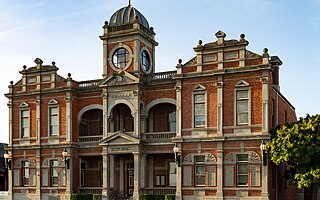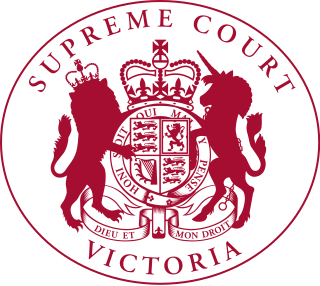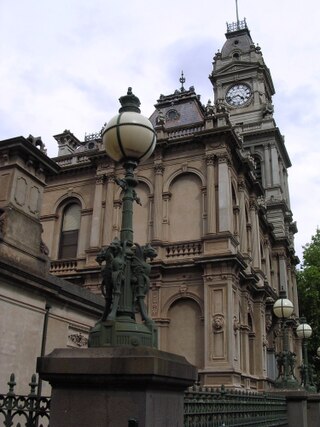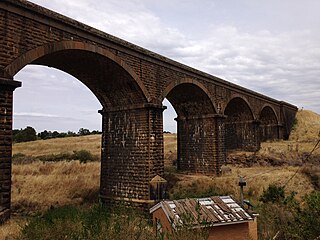
Bendigo is a city in north-central Victoria, Australia, located in the Bendigo Valley near the geographical centre of the state and approximately 150 kilometres (93 mi) north-west of Melbourne, the state capital.

Castlemaine is a town in west central Victoria, Australia, in the Goldfields region about 120 kilometres northwest by road from Melbourne and about 40 kilometres from the major provincial centre of Bendigo. It is the administrative and economic centre of the Shire of Mount Alexander. The population at the 2021 Census was 7,506. Castlemaine was named by the chief goldfield commissioner, Captain W. Wright, in honour of his Irish uncle, Viscount Castlemaine.

Victorian architecture is a series of architectural revival styles in the mid-to-late 19th century. Victorian refers to the reign of Queen Victoria (1837–1901), called the Victorian era, during which period the styles known as Victorian were used in construction. However, many elements of what is typically termed "Victorian" architecture did not become popular until later in Victoria's reign, roughly from 1850 and later. The styles often included interpretations and eclectic revivals of historic styles (see Historicism). The name represents the British and French custom of naming architectural styles for a reigning monarch. Within this naming and classification scheme, it followed Georgian architecture and later Regency architecture and was succeeded by Edwardian architecture.

Arts Centre Melbourne, originally known as the Victorian Arts Centre and briefly called the Arts Centre, is a performing arts centre consisting of a complex of theatres and concert halls in the Melbourne Arts Precinct, located in the central Melbourne suburb of Southbank in Victoria, Australia.

Parliament House is the meeting place of the Parliament of Victoria, one of the eight parliaments of the Australian states and territories.

Bendigo Senior Secondary College (BSSC) is an Australian government-funded co-educational secondary school for Year 11 and Year 12 students located in the centre of Bendigo, Victoria. It is the largest provider of VCE, VET and VCAL in the state of Victoria.

Sacred Heart Cathedral, Bendigo, is the Roman Catholic cathedral church of the Diocese of Sandhurst and seat of Bishop Shane Mackinlay. The cathedral is located in the provincial city of Bendigo, Victoria, Australia.

The Supreme Court of Victoria is the highest court in the Australian state of Victoria. Founded in 1852, it is a superior court of common law and equity, with unlimited and inherent jurisdiction within the state.
The Deniliquin railway line is a broad-gauge railway line serving north-western Victoria, Australia. The line runs from the New South Wales town of Deniliquin into Bendigo, before turning south-south-east towards Melbourne, terminating in Docklands near the central business district. It is a major trunk line both for passenger and freight trains, with many lines branching off from it.
Australian non-residential architectural styles are a set of Australian architectural styles that apply to buildings used for purposes other than residence and have been around only since the first colonial government buildings of early European settlement of Australia in 1788.
The Geelong–Ballarat railway line is a broad-gauge railway in western Victoria, Australia between the cities of Geelong and Ballarat. Towns on the route include Bannockburn, Lethbridge, Meredith, Elaine and Lal Lal. Major traffic includes general freight from the Mildura line, and grain.
The Melbourne City campus of the Royal Melbourne Institute of Technology is located in the city centre of Melbourne in Victoria, Australia. It is sometimes referred to as "RMIT City" and the "RMIT Quarter" of the city in the media.
The architecture of Mumbai blends Gothic, Victorian, Art Deco, Indo-Saracenic & Contemporary architectural styles. Many buildings, structures and historical monuments remain from the colonial era. Mumbai, after Miami, has the second largest number of Art Deco buildings in the world.

The Bendigo Post Office is a building on Pall Mall in Bendigo, a provincial city in the Australian state of Victoria. The post office backs onto and is partly surrounded by Rosalind Park. The building was built between 1883 and 1887 by the contractors McCulloch and McAlpine and designed by Public Works architect George W. Watson in the Second Empire architectural style. The building shares a great deal with its neighbouring building, the Bendigo Law Courts, and had the same builder and designer and was built at around the same time.

The Shamrock Hotel, currently trading as Hotel Shamrock, is a grand 19th-century hotel in Bendigo, Victoria, Australia, situated on Pall Mall, the city's main street.

The Taradale Viaduct is a large wrought iron box girder bridge over Back Creek at Taradale, Victoria on the Bendigo Railway in Victoria Australia. It was erected as part of the Melbourne, Mount Alexander and Murray River Railway between 1858 and 1861, and was at the time one of the largest rail bridges built in Australia.

The Malmsbury Viaduct is a large brick and stone masonry arch bridge over the Coliban River at Malmsbury on the Bendigo Railway in Victoria Australia. It was erected as part of the Melbourne, Mount Alexander and Murray River Railway between 1858 and 1861, and was at the time the largest masonry arch railway bridge built in Victoria.

The Beehive Building, also known for a time as the Sandhurst Mining Exchange, is a 19th-century building located on the historic thoroughfare of Pall Mall in the centre of Bendigo, a regional city in the Australian state of Victoria. Bendigo was called Sandhurst, after the famous British military academy, until the gold mining town's name was changed in 1891. The building's modern-day successor is the Bendigo Stock Exchange. It was designed by noted architect Charles Webb who briefly abandoned hs architectural career in Melbourne in 1851 to become a miner on the newly established gold diggings near Bendigo. The building, which contains the former Bendigo Mining Exchange, is an important part of Bendigo's Pall Mall streetscape, one of the most notable Victorian period streetscapes remaining in Victoria. The Greater Bendigo Council is exploring options to return the building to its former glory.

The Supreme Court (Building), is a court building located at 192-228 William Street in Melbourne, Australia. It is part of a complex of buildings which, together with the Supreme Court Library and Court of Appeal, are known as the Melbourne Law Courts. It is currently the home to the Supreme Court of Victoria, the most senior court in the state of Victoria, and inferior only to the High Court of Australia. The Supreme Court has occupied the site since its first sitting in February 1884.

Kerang Post Office is a heritage-listed post office at 51-53 Victoria Street, Kerang, Victoria, Australia. It was designed by the Victorian Colonial Architect, George William Watson, and was built in 1886. It was added to the Australian Commonwealth Heritage List on 8 November 2011.
















